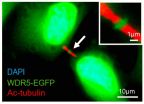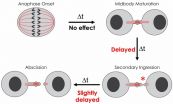(Press-News.org) The human body is a cross between a factory and a construction zone -- at least on the cellular level. Certain proteins act as project managers, which direct a wide variety of processes and determine the fate of the cell as a whole.
One group of proteins called the WD-repeat (WDR) family helps a cell choose which of the thousands of possible gene products it should manufacture. These WDR proteins fold into a three-dimensional structure resembling a doughnut -- an unusual shape that allows WDR proteins to act as stable platforms on which large protein complexes can assemble or disassemble.
A new study conducted by scientists at UC Santa Barbara reveals a novel function for WDR5, a protein known for its critical role in gene expression whereby information encoded in genes is converted into products like RNA (ribonucleic acid) and protein. In cells, WDR5 is a subunit of a five-protein complex. Mutations in members of this complex can result in childhood leukemia and other disorders affecting numerous organ systems in the body. The UCSB team worked with WDR5 in cultured human cell lines. The results of the study appear in the Journal of Biological Chemistry.
"We found that when two cells divide, WDR5 is localized to a very interesting cellular structure called the midbody," said lead author Jeff Bailey, a graduate student in UCSB's Department of Molecular, Cellular and Developmental Biology (MCDB). "In the past, although associated with cell division, the midbody was considered 'junk,' but that has changed in the last decade. Now the midbody is believed to be important during stem cell differentiation."
When a stem cell divides to produce a differentiated type of cell like a skin cell or a neuron, stem cells retain the midbody while differentiated cells do not. "This suggests that the midbody has important functions," Bailey explained. "Also, when the midbody isn't cut correctly, the cells can re-fuse, creating one cell with two nuclei. This is thought to be part of what happens when a tumor forms."
Conducted in the laboratory of MCDB associate professor Zach Ma, this new work involved the fusion of WDR5 to a green fluorescent protein molecule called EGFP. Although dense material within the midbody thwarts conventional methods of protein detection, the fluorescence of EGFP tethered to WDR5 revealed its location during cell division, or cytokinesis.
The researchers were surprised to find WDR5 in a part of the midbody called the dark zone. "It was very unexpected," Bailey said. "The presence of WDR5 outside the cell nucleus gave us a clue about its function, which we tested," Ma added.
The scientists found that not only did the protein localize in the midbody, it also contributed to abscission, the separation of two daughter cells at the completion of cytokinesis. In addition, WDR5 promotes the disassembly of midbody microtubules, the major structural components of the midbody that must be cleared before abscission can occur.
When the investigators artificially reduced the amount of WDR5 in cells, cytokinesis was substantially delayed and more cells failed to divide properly. "When histology is performed on a tumor, pathologists look for cells that have two nuclei," Bailey explained. "This can indicate that cells within the tumor are failing to properly finish cytokinesis."
Because a single protein can perform several distinct functions according to its location within a cell, it can be challenging to study one function without disrupting the others. Guided by previous structural studies, however, the UCSB team identified surfaces of the WDR5 "doughnut" that may be specific to its role in cell division.
"We have shed some light on the role of WDR5 in cytokinesis," Ma said, "which may in turn help us better understand the diverse array of physiological as well as pathological events related to malfunction of these proteins in the process of cell division."
INFORMATION:
Offering a potential early intervention for Alzheimer's disease (AD), researchers at University of California, San Diego School of Medicine and Cenna Biosciences, Inc. have identified compounds that block the production of beta amyloid peptides in mice. The study is reported April 29 in PLOS ONE.
If the results ultimately translate to human treatment, the most promising compound - a peptide dubbed P8 - could be administered to individuals at high risk of developing the disease, long before the tell-tale signs of dementia occur and perhaps with few side effects, due to ...
Understanding extinct species diets may require a greater understanding of the relationship between skull biomechanics and the animals' ancestry than previously thought, according to a new study published April 29, 2015 in the open-access journal PLOS ONE by Zhijie Jack Tseng and John Flynn from the American Museum of Natural History.
The diet of long-extinct animals may be inferred by using modern animals with similar skull shapes and tooth patterns as models, but scientists aren't sure if diet is the main factor influencing skull shape and biomechanics. To understand ...
April 24, 2015. Almost since the time of Melville's epic hunt, scientists have been fascinated by the remarkable attributes of the sperm whale and its kin, the smaller pigmy and dwarf whales. Capable of diving to great depths and gifted with an acute sense of echolocation, these animals have remained inseparable from maritime lore.
An international team of scientists, led by the Natural History Museum of Los Angeles County's Curator of Marine Mammals Dr. Jorge Velez-Juarbe, has discovered a new species of an extinct pigmy sperm whale from Panama that clarifies key aspects ...
(Philadelphia, PA) - For more than 100 years, exposing students to basic and clinical research has been an essential component of a medical school education in the United States. However, today, new models of medical education in which research plays a minimal role are likely to create a two-tiered system of education, decrease the physician-scientist pipeline and diminish the application of scientific advances to patient care.
Those are the concerns outlined in "American Medical Education at a Crossroads" - a position paper published April 29 by Science Translational ...
ANN ARBOR, Mich. -- Kaiba was just a newborn when he turned blue because his little lungs weren't getting the oxygen they needed. Garrett spent the first year of his life in hospital beds tethered to a ventilator, being fed through his veins because his body was too sick to absorb food. Baby Ian's heart stopped before he was even six months old.
Three babies all had the same life-threatening condition: a terminal form of tracheobronchomalacia, which causes the windpipe to periodically collapse and prevents normal breathing. There was no cure and life-expectancies were ...
Having to pay for dental health care can put a considerable strain on household finances in many countries, according to an international study led by King's College London.
The new study, published in the journal PLOS ONE, assessed the extent of household 'catastrophic dental health expenditure' (CDHE) in 41 low and middle income countries. Expenditure was defined as catastrophic if it was equal to or higher than 40% of the household's capacity to pay.
Up to 7% of the households surveyed in these countries had incurred catastrophic dental health expenditure in ...
New Haven, Conn.--Improving access to public toilets in South African urban settlements may reduce both the incidence of sexual assaults by nearly 30% and the overall cost to society, a study by researchers at the Yale School of Public Health and Yale School of Management found.
The research was published April 29 in PLOS ONE.
Development and human rights organizations have pointed to inadequate local sanitation facilities as a key factor in a woman's risk for physical or sexual assault. Many women in South Africa must travel out of their homes to public toilets, ...
The Public Health Agency of Sweden has developed a method of typing that can allow laboratories to faster establish the presence of hospital outbreaks of the intestinal bacterium Clostridium difficile. The findings are now published in PLOS ONE.
The Clostridium difficile bacteria exist in the intestines of 2-5 per cent of the healthy population, and is rather common among infants. In certain circumstances the bacteria can induce diarrhea in persons treated with antibiotics. The diarrhea is in some cases serious.
The majority of the cases occur at hospitals. This is ...
HOUSTON - (April 29, 2015) - Researchers in the Center for Cell and Gene Therapy at Baylor College of Medicine, Houston Methodist and the Texas Children's Hospital have expanded the use of virus-specific cell therapy in cord blood transplant patients to successfully prevent three of the most problematic post-transplant viruses affecting this group of patients that have yet to be addressed clinically - cytomegalovirus (CMV), Epstein-Barr virus (EBV), and adenovirus.
The team published their results of a clinical trial that evaluated the safety and efficacy of the therapy ...
Scientists have identified chemical markers in urine associated with body mass, providing insights into how obesity causes disease.
Being overweight or obese is associated with higher risk of heart disease, stroke, diabetes and cancer, but the mechanisms connecting body fat and disease are not well understood.
The new study, led by Imperial College London, shows that obesity has a 'metabolic signature' detectable in urine samples, pointing to processes that could be targeted to mitigate its effects on health. The findings are published in Science Translational Medicine.
Urine ...




